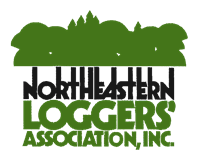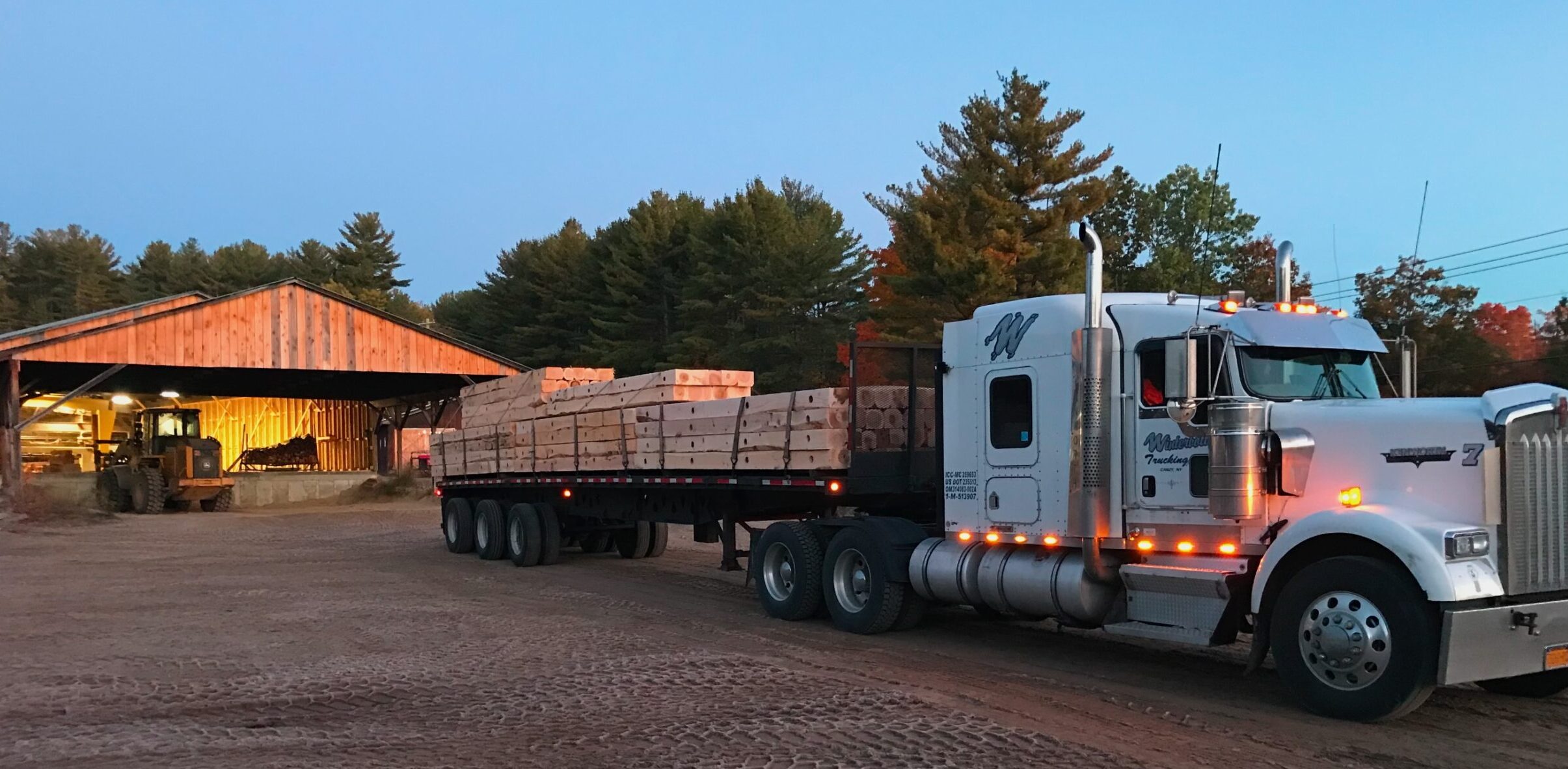Industry
Yankee Mat and the Removable Road
By Luke McNally
The wiper blades remove a thin film of moisture from my windshield and for a moment I catch a glimpse of long blonde blocks loaded down on the deck of a blurry trailer. Then the image disappears again until the wipers give me another glimpse. The truck swings wide and enters a ramp onto the Adirondack Northway. Our itineraries overlap for the next 40 miles, until the truck peels off for a powerline project and I head into the woods, another day of slicing tree trunks with blue paint. Not five miles from where I’m marking timber, another landowner tells me he sent black cherry logs down to the mill in Lewis where I live, the sub-veneer quality material fetching him about as much or more as any black cherry sawlog ever did. Crane mats, also known as logging mats or truck mats, are an increasingly popular local product whose simple design and construction contain a success story that can only be described in layers. If you’ve had it with bad news, this story is for you.
The past several years have seen a boom in powerline transmission projects and windmill construction in the North Country, as humanity’s dependence on an increasingly more intricate electrical grid has experienced not only growth but also growing pains. And these projects use a lot of crane mats. Mats are used and laid across anywhere that is wet in the forest so that they displace the weight of a machine, reducing soil compaction and eliminating soil erosion. A lot of the crane mats used locally are made in Lewis, New York, from local material, crafted into portable, reusable roads and bridges at Yankee Mat Company.
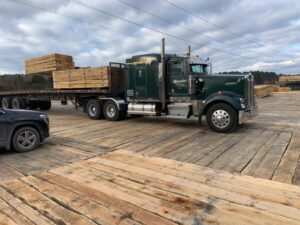
At Yankee Mat, manager Todd Cornwright has much to be proud of. His father and grandfather ran the company back when it was still Cornwright Lumber until they shut down in 2006. Then in 2020, Cornwright was approached by the parent company in New Hampshire. They wanted to reopen the mill, not for lumber but something slightly different: the log mat, perhaps America’s most underappreciated industrial, environmental, and forestry product.
“Older folks in the community, they enjoy seeing the lights on at the mill,” says Town Supervisor, Jim Monty, who I’d spoken to about the town’s logging history. “Many of them worked there when they were younger. It’s a point of pride for the town to have the mill open again.”
Yankee Mat Company is currently cranking out just under 6 million board feet a year, and pulling raw materials from as far as the Catskill Mountains in southern New York and the forests of New Hampshire. Most of it, however, comes from woodlands in New York’s northern counties of Essex, Clinton, Warren and Franklin, and much of it goes right back out to logging, windmill, and powerline projects in the same region. Electrical transmission lines throughout New England make up most of Yankee Mat’s business customers.
A mat log is squared up on four sides and typically 8 inches thick. Five squared off timbers, usually 16 feet long, are drilled from both sides and bolted together with big hardware – and that’s really all there is to it. Yankee pays $550/ thousand board feet (at the time of writing) for mat logs. Most hardwood species are good enough for a mat and the mill will take a log that contains some defects.
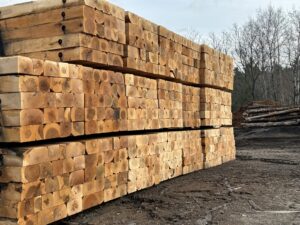
“With a ten-inch, two-face hard maple worth about $450 bucks [per MBF] right now, it’s become a bigger outlet for some of those lower grade logs, which has really helped the industry,” says Rob Fields, owner of Silver Hill Forestry in Essex County. Rob first started using mats to cross wet areas on log jobs, but he quickly discovered that he could make truck roads and temporary bridges that can cross a semi-truck over a stream. Four log stringers for a skidder or steel beams for a truck, a few mats and an approach, and you’re across the river without any erosion or sedimentation of the water.
“When you’re done, you pick up the mats and it’s like you were never there,” says Fields. And as Fields points out, “You can’t reuse stone. You can only use it once. We started buying mats immediately after the mill reopened. It took a minute to get the contractors to start cutting sawlogs for mats. But eventually it shook up the firewood market around here. We call it veneer-cordwood, and that’s a joke, obviously. But that’s just how markets work.” Now Yankee Mat does business with about 50 suppliers, everyone from Lyme Adirondack Forest Company and F&W right down to one-man cable-skidder operations.
I asked Cornwright what his biggest challenges are, expecting to hear the usual culprits – regulation, fuel prices, trucking, workforce… He pauses, then smiles.
“Things are good. My help is good. I have a good crew. They range from barely 18 to significantly older.” He smiles again.
I pressed Cornwright for more, asking, “If you had a magic wand, what would you do differently?”
“Getting rid of the side boards is a struggle,” he says. “If I could set it up differently, every aspect of the tree would be utilized. I’d like to have room to grow. We would have a pallet mill and make grade stakes here.”
So, it’s good for the industry, the economics are there, putting rural people back to work as well. And as the last remaining sawmill for miles around, the outfit offers a sense of identity for a place that really needs the boost. Mats are American grown, milled, trucked, and consumed, so they’re independent of global markets. With so many positives, there must be a catch? Surely there must be some sort of trade-off for the environment, for the tax payer, a burden some other people somewhere else must shoulder? Right? Wrong. Mats are wonderful at interacting with the natural world and humanity’s various conservation initiatives.
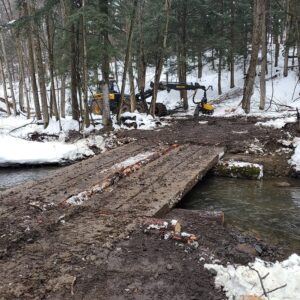
Here’s why:
Unlike other dubious claims some alternative products make or fuel that ends up polluting the world in some other way, I really can’t find a downside to mats (sure somewhere someone will cry about a tree being cut, and ironically, they may reach for a tissue). For better or worse, humans are obsessed with roads. We drive to everything, including national parks. We build trails and roads for recreation, and in the forest industry, forest roads and skid trails are a necessary evil and expense for both silviculture and production. Disciplines such as road ecology and fisheries biology have sought to understand and mitigate the damage that roads do to wildlife, just as engineers have wrestled with how culverts and bridges interact with stormwater.
What logging mats offer us is the recyclable and removable road. Instead of having to mine, crush, truck, spread and abandon a stone and gravel road, mats can build out a temporary road almost anywhere. When you’re done, the mats go back on the truck and the reusable material moves to its next temporary location.
“They don’t just prevent the tires from digging ruts,” Cornwright tells me. “It’s how the water moves – across the landscape.”
In this instance, I don’t have to use my fifty-dollar phrase, hillslope hydrology, to articulate what Cornwright said just as well. “How the water moves across the landscape” describes the basic tenet of surface water in a watershed. The water moves until it soaks in, or it soaks in until it can’t anymore and then it moves, downhill. Such processes include basic soil physics and hydrology including infiltration and, in its absence, a flood. When water hits a stone road, that watershed becomes permanently artificial. Not so with mats. The water can go through, under and around the mat, and since the mat road will only be there for a little while anyway, the natural hydrology of the hillside or valley bottom will go right back the way it was once the mat is removed. Mats eliminate the need for hard armoring. In the built environment, public roads or urban stormwater, hard armoring is very necessary, but in a natural environment, armoring is destructive.
That’s in addition to the original purpose of the mat, which was to displace the weight of machinery crossing wetlands, which prevents the rutted-up mess that nobody wants to see. Finally, mats can be laid across stringer logs to make a bridge. Such simple bridges eliminate the need for the ecologically destructive culvert. Corrugated pipe crossings choke the diameter of the stream down to a fraction of its width. Under normal conditions, culverts eventually become perched so that fish and turtles can’t get through the pipe. And the accelerated velocity of water gushing through a pipe blasts a downstream scour pool into the riverbed and chews up the bank on both flanks. When rivers flood, culverts under roads are vulnerable to a blowout. Engineers are working to make culverts wider and bottomless, but this is prohibitively expensive.
Forestry and logging however, provide a simple solution. Replace the undersized culverts on rural roads, driveways, mountain bike and hiking trails with the austere mat log bridge. The water body maintains its natural bankfull width intact, and all the salamanders, fish, deer, elk, and harbor seals of the world can fit underneath it without problem. Forestry has been doing this for pennies on the dollar with temporary skidder bridges for years in the industry sector, but the fish biologists and ecologists hardly noticed.
If I were a betting man, I’d go down to my local watering hole and try to find a bookie that would take a bet on logging mats, that they will redefine how we engineer transportation in rural America. Sure, they rot out eventually and have to be replaced. But they’re cheap and renewable and only the world’s most dismissive environmental advocates will dispute the affirmation that wood displaces our more destructive building materials. From the first cave people’s friction fire to the engineering challenges of the modern age, wood still wins.
To subscribe to The Northern Logger, go to https://www.northernlogger.com/magazine-preview/
